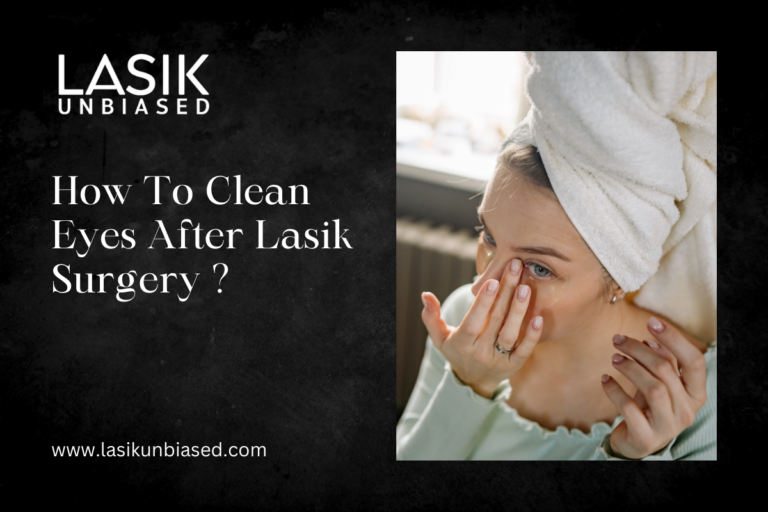LASIK (Laser-Assisted in Situ Keratomileusis) surgery is a popular and effective procedure that can significantly improve vision, eliminating or reducing the need for glasses or contact lenses. While LASIK is generally a quick and safe procedure, recovery is critical to ensuring the best results and preventing complications. One crucial aspect of post-LASIK care is cleaning your eyes carefully, as the eyes are sensitive during healing.
This article will discuss how to clean your eyes properly after LASIK surgery to ensure proper healing, avoid infection, and promote a successful recovery.
Why Cleaning Your Eyes After LASIK is Important
Proper eye cleaning is crucial because improper cleaning or exposing your eyes to dirt, bacteria, or harsh chemicals can lead to infections or other complications. Additionally, during the early recovery period, your eyes may feel dry, itchy, or irritated, making it essential to handle them gently.
Proper eye hygiene can help prevent infection, reduce irritation, and ensure that your eyes heal correctly so you can enjoy the long-term benefits of clear vision.
General Guidelines for Cleaning Your Eyes After LASIK Surgery
1. Avoid Touching or Rubbing Your Eyes
One of the most important things to remember after LASIK surgery is to avoid touching, rubbing, or pressing on your eyes. Even though your eyes may feel dry or irritated, rubbing them can disrupt the healing process, especially the corneal flap, which could affect your vision and the outcome of the surgery.
If your eyes feel uncomfortable, it’s better to use lubricating eye drops, as recommended by your surgeon, rather than touching your eyes.
2. Wait at Least 24 Hours Before Cleaning Your Eyes
Immediately after LASIK surgery, you should refrain from touching or cleaning your eyes for at least 24 hours. During this time, the corneal flap is still settling and healing, so it’s vital to avoid any irritation or potential contamination. After 24 hours, you can begin cleaning your eyes gently, but always follow your surgeon’s instructions on when it is safe to start eye care.
3. Use Prescribed Eye Drops
Your surgeon will likely prescribe lubricating eye drops to help keep your eyes moist and reduce irritation after LASIK. These drops also help wash away any dust or debris that may have accumulated. You should use these drops as directed, especially during the first few weeks after surgery. The prescribed drops ensure your eyes remain hydrated and protected while healing.
If your surgeon provides antibiotic or anti-inflammatory drops, follow the prescribed schedule carefully to prevent infection and inflammation.
4. Gently Clean the Eye Area With a Soft Cloth or Cotton Pad
When you begin cleaning around your eyes, it’s essential to do so gently. Here’s how to clean the eye area carefully:
- Use a clean, soft cloth or cotton pad: Wet the cloth or cotton pad with clean water or saline solution (as recommended by your surgeon).
- Wipe gently around the eyes: Using light pressure, gently clean around your eyes, especially on the eyelids and lashes. Avoid touching the eyes directly, and never use harsh or irritating products like makeup removers or cleansers that contain chemicals.
- Avoid rubbing: Be sure not to rub the eye area to prevent any stress on the eyes. Wipe the area gently to remove any dirt, makeup, or residue.
5. Avoid Getting Water in Your Eyes
During the first few weeks after LASIK surgery, you should avoid getting water directly into your eyes. Water, especially from showers, pools, or hot tubs, can introduce bacteria that may increase the risk of infection. Here are a few tips to avoid water exposure:
- Close your eyes tightly when washing your face or in the shower. If water comes into contact with your eyes, ensure they remain tightly closed.
- Use a clean washcloth: You can gently clean your face, but be careful not to get water in your eyes.
- Avoid swimming: To minimize the risk of infection, you should avoid swimming in pools, hot tubs, or lakes for at least 2 to 4 weeks after LASIK.
6. Avoid Eye Makeup for a Few Weeks
During recovery, avoid using eye makeup, including mascara, eyeliner, and eyeshadow, for at least one to two weeks after LASIK surgery. Makeup can introduce bacteria to the delicate eye area, increasing the risk of infection. Additionally, makeup particles may irritate the eyes, especially if they get in the eyes or on the corneal flap.
If you must wear makeup, wait until your surgeon gives you the green light. Your surgeon typically clears you to use makeup once your eyes fully heal.
7. Be Cautious Around Dust, Smoke, and Pollutants
After LASIK surgery, your eyes may be more sensitive to environmental factors such as dust, smoke, and pollutants. These particles can cause irritation or discomfort and potentially interfere with healing. To protect your eyes:
- Avoid dusty or smoky environments: Avoid places with high dust, smoke, or other airborne particles, especially during the first few days after surgery.
- Wear sunglasses outdoors: Sunglasses can help shield your eyes from dust, wind, and UV light, providing additional protection while recovering.
8. Follow Up with Your Surgeon
After LASIK surgery, follow-up appointments with your surgeon are essential to monitor your recovery. These check-ups allow your surgeon to ensure that your eyes are healing correctly and address any concerns you may have about your vision or cleaning routine. Always attend these appointments as scheduled and consult your surgeon for personalized advice on caring for your eyes during recovery.
When to Seek Medical Attention
While most people recover from LASIK surgery without any significant issues, it’s essential to seek medical attention if you experience any of the following:
- Severe pain or discomfort that doesn’t improve with lubricating eye drops
- Sudden vision changes such as blurry vision, halos, or double vision
- Redness or discharge from the eyes, which could indicate an infection
- Excessive dryness that doesn’t improve with eye drops or feels more severe over time
If you notice these symptoms, contact your surgeon immediately to address the issue and avoid potential complications.


